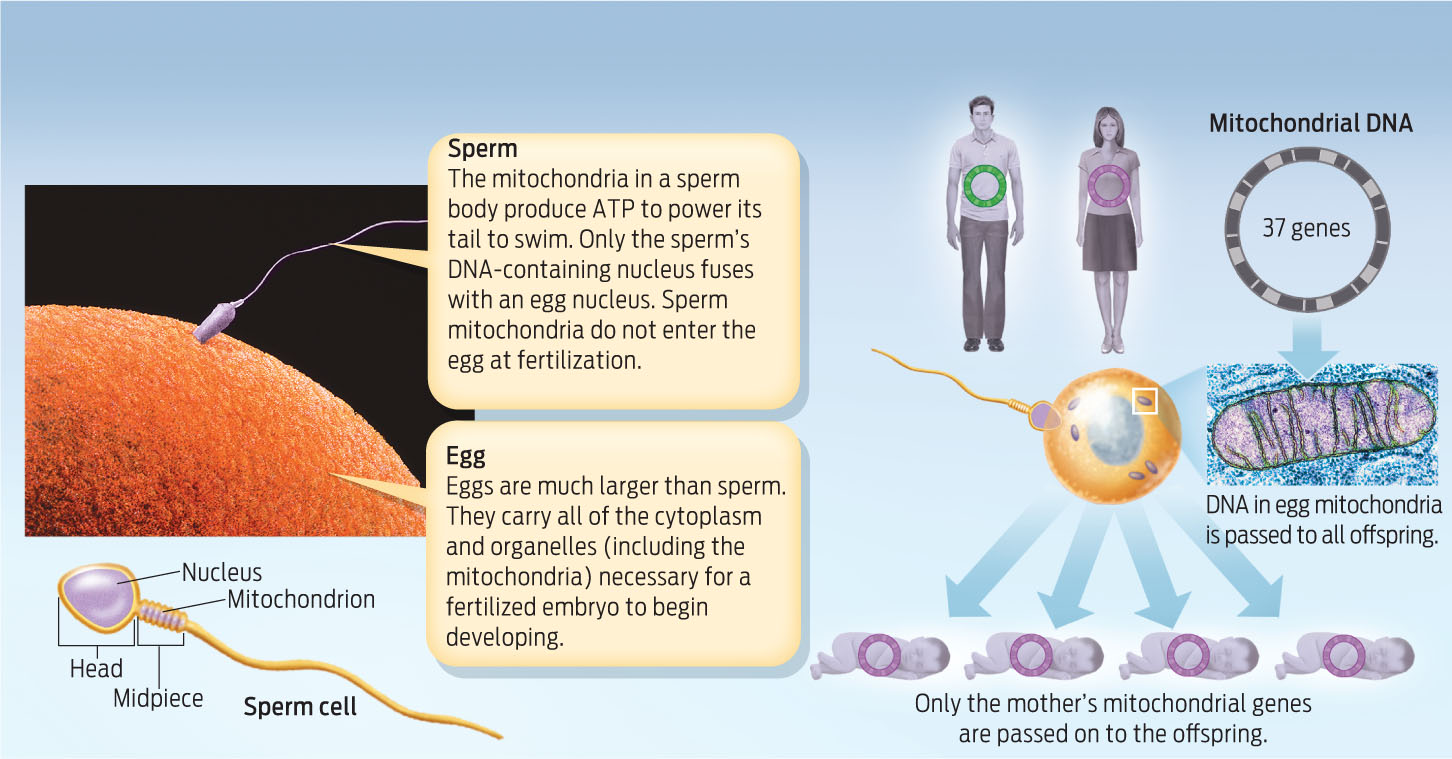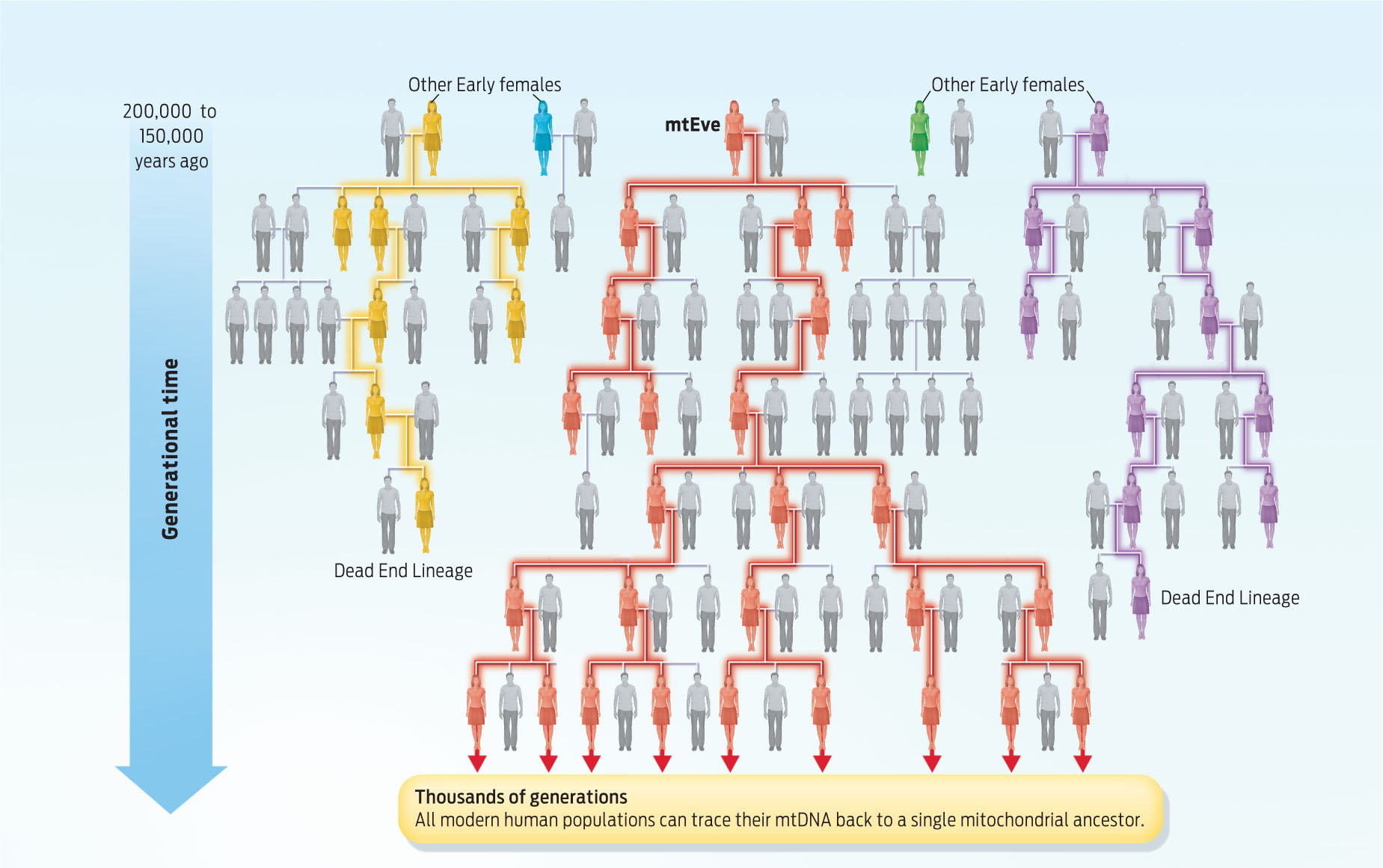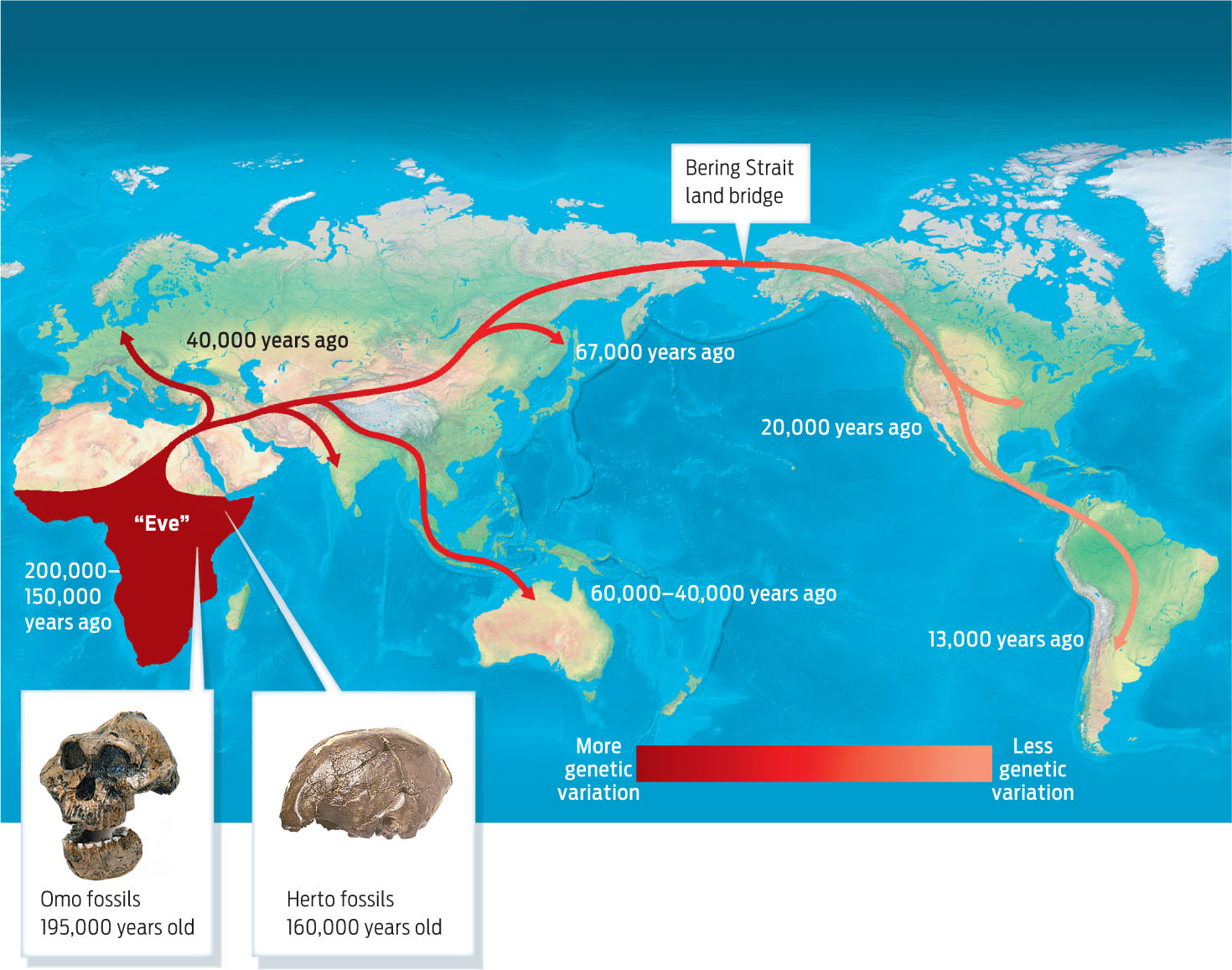OUT OF AFRICA
MITOCHONDRIAL DNA (MTDNA) The DNA in mitochondria that is inherited solely from mothers.
If light and dark skin tones developed over time, then at some point in history, all humans likely had the same skin tone. This conclusion—a logical extension of Jablonski’s work—is supported by genetic studies suggesting that anatomically modern humans first evolved in Africa.
In 1987, a team of geneticists led by Allan Wilson of the University of California at Berkeley used mitochondrial DNA (mtDNA)—genetic material we inherit solely from our mothers—to construct an evolutionary tree of humanity. Mitochondrial DNA is DNA located in the mitochondria in all our cells. Unlike nuclear DNA, which is inherited from both parents in most multicellular organisms (including humans and other animals), and which undergoes recombination during meiosis, mtDNA passes from mothers to offspring essentially unchanged. That’s because sperm do not contribute their mitochondria to the newly formed zygote (INFOGRAPHIC 20.5).
When egg and sperm fuse during fertilization, sperm contribute only nuclear DNA to the nucleus of the newly formed zygote. The egg provides all other organelles, including mitochondria. Consequently, only mothers contribute mitochondrial DNA to their children.

Like nuclear DNA, mtDNA mutates at a fairly regular rate, although it appears to mutate faster than nuclear DNA. A mother with a mutation in her mtDNA will pass it to all her children, and her daughters will pass it to their children in turn. Because these mutations pass down without being combined and rearranged with paternal mitochondrial DNA, mtDNA is a powerful tool by which to track human ancestry back through hundreds of generations.
437
Wilson and his colleagues Rebecca Cann and Mark Stoneking collected mtDNA from 147 contemporary individuals from Africa, Asia, Australia, Europe, and New Guinea. On the basis of the mtDNA sequence patterns—that is, the number of individual nucleotide differences from one person to the next—researchers were able to determine how closely or distantly related the individuals were: individuals sharing nearly identical sequences are more closely related than individuals with many sequence differences between them. As mitochondrial DNA mutates at a more or less constant rate, the researchers could also tell how long it had been since groups diverged from one another, based on the number of differences. Using this information, the researchers created an evolutionary tree, grouping first individuals that shared the most similar mtDNA sequences, and then grouping these groups with respect to one another, until finally the largest group—containing all the others—was reached. A computer program helped them choose the most statistically probable tree.
The researchers found that branches of the tree from all five geographical areas could be traced back to a single female ancestor who lived in eastern Africa some 200,000 to 150,000 years ago. In other words, if every person on the planet were to construct a family tree that listed every female ancestor for thousands of generations back in time, they would all eventually converge at a single common female ancestor. As a newspaper reporter put it, the researchers had found “Mitochondrial Eve.”
While catchy, the nickname “Eve” is misleading in a number of respects. This single female common ancestor wasn’t the only female living at the time; she was merely one female in a population of many ancient humans. Nor was she the only female to leave descendants. But Eve’s mitochondrial DNA is the only mitochondrial DNA that modern humans still carry today. How can this be? The reason is simple: while other females living at the time also had descendants, the lines of these descendants either died off, perhaps in a bottleneck event (see Chapter 15), or left only sons. When that happened, their mitochondrial DNA lines became extinct. All humans today can trace their mitochondrial DNA back to Mitochondrial Eve (INFOGRAPHIC 20.6).
Many women of Eve’s generation left descendants, but only Eve’s mitochondrial DNA survives among humans today.

438
Interestingly, the tree Wilson generated had two major branches: one that leads to individuals now living in all five of the regions studied—Asia, Australia, Europe, New Guinea, and Africa—and one that leads only to modern-day Africans. The mtDNA of people on the exclusively African branch had acquired twice as many mutations as the mtDNA of people on the rest of the tree. The most likely interpretation of these data, the scientists reasoned, was that the African mtDNA had had more time to accumulate mutations, and was consequently older, evolutionarily speaking. This would mean that humans likely originated in Africa, where they formed several ancestral populations. After some period of time, one group of Africans left the continent, and their descendants continued to migrate to other continents, eventually becoming the ancestors of modern-day Asians, Australians, and Europeans. Evidence suggests this migration began around 70,000 years ago.
439
Since Wilson’s study, additional evidence continues to back the “out of Africa” hypothesis. Fossil discoveries in Ethiopia in 2003 and 2005 represent the oldest known fossils of modern humans—160,000 and 195,000 years old, respectively—and plug a major gap in the human fossil record. Both sets of remains date precisely from the time Wilson and his colleagues think that Mitochondrial Eve lived in eastern Africa. The fossil discoveries provide evidence that anatomically modern humans were living in that region around the same time that Mitochondrial Eve lived, and provide further evidence that the earliest humans originated in Africa.
This hypothesis is also supported by research that sampled genetic diversity from nuclear DNA. In a 2008 study, for example, Richard Myers, of the Stanford University School of Medicine, and colleagues found less and less genetic variation in people the farther away from Africa they lived—the same pattern of variation that scientists have found in human mtDNA sequences. This finding suggests that as each small group of people broke away to explore a new region, it carried only some of the parent population’s alleles. Consequently, genetic diversity decreased in tandem with the distance people traveled away from Africa—a classic example of the founder effect described in Chapter 15 (INFOGRAPHIC 20.7).
Genetic evidence suggests that the earliest modern humans originated and evolved for thousands of years in Africa before a group of them migrated to the other continents. Because African populations are older, they have more genetic diversity. As migrating descendants only took a fraction of the alleles present in Africa, there is less genetic variation in other regions.

440